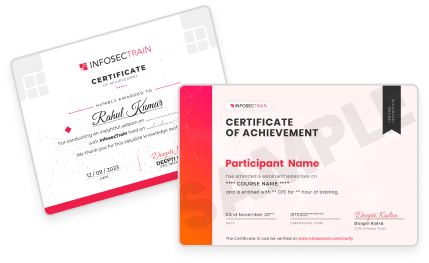Program Highlights
Master the art of web application security with InfosecTrain’s expert-led Web Penetration Testing program. This hands-on masterclass dives deep into real-world attack scenarios from SQL Injection and XSS to SSRF, IDOR, and Command Injection using tools like Burp Suite, Nmap, Metasploit, and Wireshark. Learn to exploit, analyze, and report vulnerabilities effectively while strengthening your understanding of HTTP, web architectures, and modern web defenses. Whether you’re a beginner or a working professional, gain actionable skills, access curated resources, and get industry-ready with lab-based learning and interview prep.
32-Hour LIVE Instructor-led Training
Real-world Scenarios
Vulnerable Webserver Practice Labs
Real-time Simulations
Interview Preparation & Career Guidance
Learn from Certified Experts
Training Completion Certificate
Post Training Support
Access to Recorded Sessions
Learning Schedule
- upcoming classes
- corporate training
- 1 on 1 training
Looking for a customized training?
REQUEST A BATCHWhy Choose Our Corporate Training Solution
- Upskill your team on the latest tech
- Highly customized solutions
- Free Training Needs Analysis
- Skill-specific training delivery
- Secure your organizations inside-out
Why Choose 1-on-1 Training
- Get personalized attention
- Customized content
- Learn at your dedicated hour
- Instant clarification of doubt
- Guaranteed to run
Can't Find a Suitable Schedule? Talk to Our Training Advisor
- 1. Introduction to Web Penetration Testing
- Fundamentals of web application penetration testing.
- Importance of securing modern web applications.
- Testing Methodologies: Explore Black Box, White Box, and Grey Box testing approaches
- 2. Understanding HTTP and Web Technologies
- HTTP communication and protocols.
- HTTP request/response headers and their significance.
- Practical demo: Analyzing HTTP communication with Wireshark and Netcat.
- Deep dive into HTTP methods, verbs, and status codes.
- HTTP verb tampering with Nmap and Metasploit.
- HTTP/HTTPS comparison and TLS/SSL handshake.
- 3. Deep Dive into Web Penetration Labs and Advanced Traffic Interception
- Understanding of the web penetration lab setup and the functionalities of the Kali Linux Operating System.
- Setting up and configuring Burp Suite for HTTP/HTTPS traffic interception.
- Understanding target scope and creating project files.
- Burp Suite tools: Dashboard, Proxy, Intruder, Repeater, Scanner, Collaborator, and Extender.
- Configuring SSL/TLS certificates for secure interception.
- Advanced traffic manipulation and injection using Burp.
- 4. Information Gathering and Reconnaissance
- Passive and active reconnaissance techniques.
- Extracting application endpoints, technologies, and server configurations.
- Tools for vulnerability scanning: Nmap, Nikto etc.
- Techniques to identify hidden endpoints and sensitive data.
- Exploiting version disclosure vulnerabilities.
- 5. Fuzzing, Brute Force, and Dictionary Attacks
- Parameter fuzzing techniques to discover hidden vulnerabilities.
- Directory brute-forcing using Gobuster and FFUF.
- Password brute-forcing with Hydra and dictionary attacks.
- Cracking hashed passwords using tools like John the Ripper and Hashcat.
- Authentication bypass using advanced SQL injection techniques.
- 6. HTTP Cache Exploitation
- Understanding private vs. public cache mechanisms.
- Exploiting HTTP response cache headers.
- HTTP parameter pollution and smuggling attacks.
- HTTP cache deception techniques and demonstrations.
- 7. HTTP Session Management
- HTTP basic authentication and session cookies.
- Understanding cookie attributes: Secure, HttpOnly, and SameSite.
- Exploiting session fixation and session hijacking vulnerabilities.
- Advanced MITM (Man-in-the-Middle) attack scenarios.
- Session management best practices for security.
- 8. Same-Origin Policy (SOP): The Core of Web Security
- Fundamentals of SOP and cross-domain requests.
- Understand the working of URL and Browser.
- Browser handling of JavaScript, frames, windows, and sites.
- Limitations of SOP and common bypass techniques (jsonp)
- CORS misconfigurations and CSRF attack exploitation.
- Advanced CORS attack scenarios and mitigation techniques.
- 9. File Upload Vulnerabilities
- Understanding malicious file upload vulnerabilities.
- Exploiting file upload functions to bypass restrictions.
- Local File Inclusion (LFI) and Remote File Inclusion (RFI) attacks.
- Practical demos: Web shells using Netcat, Python, and PHP.
- Remote Code Execution (RCE) via LFI/RFI exploitation.
- Null-byte extension bypass techniques.
- Mitigation.
- 10. SQL Injection Exploitation
- Understanding SQL queries and three-tier architecture.
- In-band, blind, time based and second-order SQL injection techniques.
- Exploiting SQL injection to extract sensitive data.
- Advanced SQLMap usage for database exploitation using sqlmap.
- Real-world SQL injection scenarios and mitigation techniques.
- 11. Cross-Site Scripting (XSS)
- Types of XSS: Stored, Reflected, and DOM-based attacks.
- Session hijacking and cookie theft using XSS.
- Exploiting XSS vulnerabilities with BeEF framework.
- XSS bypass techniques for modern web defenses.
- Effective mitigation strategies against XSS.
- 12. Indirect Object Reference (IDOR)
- Privilege escalation in web applications.
- Understanding horizontal and vertical privilege escalation.
- Exploiting IDOR in files, APIs, and databases.
- Advanced IDOR attack techniques and Mitigation.
- 13. Server-Side Request Forgery (SSRF)
- Identifying SSRF vulnerabilities in web applications.
- Exploiting blind SSRF vulnerabilities for data exfiltration.
- Escalating SSRF to Remote Code Execution (RCE).
- Mitigation techniques for SSRF vulnerabilities.
- 14. Path and Directory Traversal
- Discovering and exploiting path traversal vulnerabilities.
- Advanced techniques for bypassing path restrictions and filters.
- Real-world directory traversal attack scenarios.
- 15. Command Injection
- Identifying and exploiting basic command injection vulnerabilities.
- Discovering blind and asynchronous blind command injection attacks.
- Using Burp Collaborator for advanced exploitation.
- Real-world command injection and mitigation.
- 16. XML Injection and XXE Attacks
- Understanding XML structure and DTDs (Document Type Definitions).
- Exploiting XXE vulnerabilities and triggering OOB resource interactions.
- XML injection scenarios and mitigation techniques.
- 17. Bonus: Web Penetration Testing Report
- Understanding OWASP Top 10 framework.
- Scoring vulnerabilities using CVSS (Common Vulnerability Scoring System).
- Crafting professional penetration testing reports.
- Proof of Concept (PoC) creation and documentation.
- Presenting findings to stakeholders effectively.
- Bonus Content
- Interview Preparation and Guidance
- Vulnerable webserver Lab for practise
- Cheat sheet for various attacks like SQL Injection, XSS Injection, XML etc
- Custom built list/ repos of openly available resources
- System Requirements
- 1. Hardware:
- CPU: Intel i5/i7 or AMD Ryzen 5/7 (Quad-core or better)
- RAM: 8 GB (minimum), 16 GB (recommended)
- Storage: 50 GB SSD (minimum), 250 GB (recommended)
- 2. Software:
- Host OS: Kali Linux (recommended), Windows 10/11, or Ubuntu
- VM software: VMware Workstation or VirtualBox
- Essential tools: Burp Suite, Kali Linux.
- 1. Hardware:
How We Help You Succeed
Vision
Goal
Skill-Building
Mentoring
Direction
Support
Success
Your Trusted Instructors
10+ Years of Experience
Words Have Power

The training was awesome. Helped me clear my concepts and also reduced my preparation time to 1/3rd. Thank you, trainer, for all your dedication to bring your gladiators to pace.

I loved the training. Coming for more soon. The trainer is easily reachable and helpful.. I loved the staggered payment option given.

I must say the admin team is excellent and punctual. The trainers are actually the nerve of the team and know how to engage with the students across all the topics.

Thoroughly enjoyed the course and the continuous support from the entire team..

It was a good experience. Looking forward to career growth with Infosectrain. Thank you

Really interesting courses are delivered by really knowledgeable instructors. Worth the fees
Success Speaks Volumes
Get a Sample Certificate

Frequently Asked Questions
What is Advanced Web Application Penetration Testing (AWAPT) Training?
AWAPT is an expert-level course designed to equip professionals with advanced techniques to identify, exploit, and mitigate complex web application vulnerabilities.
Who should take the Advanced Web Application Penetration Testing Course?
This course is ideal for:
- Penetration Testers
- Security Analysts
- Developers
- IT Professionals
- Security Consultants/Cybersecurity Professionals
- Bug Bounty Hunters
- Students
What are the prerequisites for enrolling in Advanced Web Application Penetration Testing online Training?
- Basic understanding of web technologies (HTTP, HTML, JavaScript, etc.).
- Basic understanding of Linux and Windows.
- Basic understanding of Database and Networking.
- Knowledge of programming languages like Python, Java, or PHP is beneficial. (optional)
Is the Advanced Web Application Penetration Testing (AWAPT) Training available online?
Yes, the AWAPT training is available online in a live, instructor-led format.
What will I learn in the Advanced Web Application Penetration Testing Course?
Participants will master advanced attack techniques including XSS, SQLi, IDOR, SSRF, and more, with hands-on labs, reporting strategies, and real-world exploitation scenarios.




 1800-843-7890 (India)
1800-843-7890 (India)